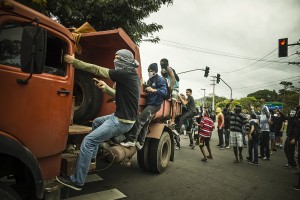In today’s socially effervescent Brazil, social media are being used to mobilise communities for social action. In this post, Lea Rekow introduces journalist collective Mídia NINJA to show how they are capitalising on these tools to radically change the way news and information are produced and shared in Brazil.
No matter on which side of the social divide one resides, the reality of living in Brazil is inextricably intertwined with issues of social exclusion. For informal and under-represented populations, the use of social media is proving to be an effective communication tool through which to mobilise, act, reveal, and visibly inject into this complex social reality.
Brazil’s informal and low-income communities, though subject to intense socio-economic disadvantage, are galvanising through the use of basic social media platforms, to mobilise in ways that are resulting in significant impact on the formal city. Popular sites such as Facebook and YouTube have already fundamentally changed the way these communities galvanise around social issues. In fact, Facebook users were principally responsible for energising Brazil’s massive protests during the summer of 2013, in which more than a million people in over one hundred cities took to the streets in massive demonstrations.
Sparked to contest a 20 cent hike in bus fare, the protests quickly spread to rouse demonstrations about the extensive political corruption which permeates much of Brazilian government. A violent series of police crackdowns ensued, spurring further public resentment that opened up a whole range of grievances about critically inadequate public services, the extreme divide in wealth, pervasive racial discrimination, and the endemic nepotism that permeates throughout the country.

The protests, largely networked through the Anonymous movement’s Facebook page, also led to the rise of the guerrilla journalist collective, Mídia NINJA, who used basic networked platforms as a response to, and a protection mechanism against the police brutality perpetrated on demonstrators. The phenomena of the Mídia NINJA movement grew out of a mix of amateur and expert journalists armed with smart phones, cameras and gas masks – the new tools of street protest reportage in Sao Paulo and Rio de Janeiro. During the protests, which occurred mostly in June and July, Mídia NINJA were on the very dangerous frontlines of this explosive protest movement. They recorded and live-streamed almost every conflict with police in the ongoing anti-corruption demonstrations outside the home of Rio state’s governer, Sérgio Cabral. At the same time, they were at the forefront of the long-running occupation of the city council, and in the marches at the doors of the TV Globo media conglomerate headquarters.
Though the demonstrations largely dissipated by the end of August 2013, the journalists’ collective continues to grow in influence and size, providing a channel for popular discontent with politics – and a public voice of dissent. Mídia NINJA now claims over 2,000 collaborators in more than a hundred cities, with a Facebook page that has 282,000 likes.
Mídia NINJA has also exposed a slew of illegal police infiltrations and unlawful arrests. In Rio, a member of the group filmed an alleged police officer (disguised as an activist) throwing a molotov cocktail into the crowd to incite violence. Though police denied the claim, the coverage was broadcast by Globo TV and others — and later served as evidence for the defense of a wrongfully arrested protestor.
As amateur content creators, the NINJAs are leaving the mainstream in their wake, fearless in the face of being tear gassed, beaten, shot, and even being hit by grenade fragments. This, together with their staunch commitment to not cutting or censoring their footage has promoted deep respect and gained the group a devout following.
Mídia NINJA was originally formed in 2011, and grew out of the communications arm of a cluster of student cultural collectives known as Fora do Eixo (“off-axis”). In Portuguese, the NINJA acronym stands for independent narratives, journalism and action. Its initial role was to broadcast concerts and conferences, but it rapidly began covering incidents in the favelas, small-scale protests, and other political events that mainstream media did not report on.
As the group continues to grow, so does their impact. Anonymous continues to point to their work, they are collaborating with The Bar Association on issues of media freedom and police brutality, and even Brazil’s mainstream television and print media, Globo and Folha, now follow the movement and acknowledge their impact on the country’s media framework.
The Mídia NINJAs rely heavily on volunteers and donations for living and travel expenses, accommodation, equipment, and even a communal wardrobe. By working as cheaply as possible, with methods that are easy to replicate, they can encourage participation by a range of collaborators.
What they exemplify is how the overwhelming amount of corporate, profit-driven and lowest-common-denominator media is being displaced by consumer accessible, networked forms of storytelling and information dissemination. This access to ubiquitously available tools is allowing, and perhaps even motivating, a diverse mix of content creators to participate in changing the world outside their front doors.

For those communities who suffer from social exclusion, as numerous studies have shown, the caricatures presented by today’s industrial-entertainment complex can be particularly destructive. Yet easily accessible social media, and low-cost ubiquitous consumer platforms, are the perfect tools to circumnavigate the often treacherous mainstream media.
By democratising digital storytelling, the NINJAs are challenging Brazil’s traditional oligarchical gatekeepers stranglehold on the nation’s print, radio, and television media. In doing so, they are changing the country’s media landscape. At the same time, groups like Mídia NINJA are announcing the active presence of local, networked communities that are determined to make an honest attempt to disseminate important information about Brazil’s critical issues, to make them accessible and available to the general public and, in particular, to its under-represented majority.
No doubt they will constitute an important part of the reportage we see over the next month as the World Cup unfolds.
This text was adapted from a contribution made to the pending publication, “Urban Interaction Design: Toward City Making.” licensed under CC BY-SA.
Lea Rekow is founding director of Green My Favela, an urban gardening project based in the favelas of Rio de Janeiro.
The views expressed on this post belong solely to the author and should not be taken as the opinion of the Favelas@LSE Blog nor of the LSE.
Please read our comments policy before commenting.





